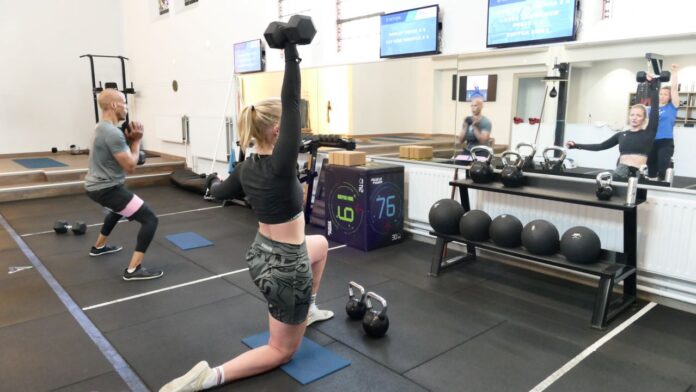When moving weight, the body depends on its foundation. Only then can it safely apply the proper integration of bone and muscle to perform an exercise correctly.
Anchoring entails applying proper isometrics to set the foundations of force production within your body for safe and effective strength training.
A herniated disk, torn ACL, ruptured Achilles and damaged meniscus, are a few of the client ailments we see frequently. Injuries such as these come from a simple misapplication of force; strength efforts (often easy ones) performed without foundation, integration, or intention; in short – without thought.
Few people have said to me “I injured myself in the gym.” But PLENTY has been said, “I injured myself picking up my kid’s toys”… “getting out of the shower”…” putting something away overhead”… “while out drinking with friends.” All of them, just average daily tasks of living.
So how do we safely avoid these ”oops” injuries that can quickly alter the quality of our lives? The answer is simple, by applying some awareness to our efforts in the gym and especially outside the gym. When moving a weight, the body depends on the nature of its foundation FIRST and only then is followed by the necessary integration of bone and muscle. I call this process “anchoring,” and it can be developed through proper isometric application and healthy functional mobility.
Sometimes the whole does NOT outweigh the sum of its parts!
Take for example the barbell curl. Look closely in the mirror when next performing this action and ask yourself these questions as you setup:
- As the bar settles into its starting position, are the moving pieces already starting to give?
- Do the wrists extend backwards?
- Can you open the elbows completely without the shoulders rounding forward?
Now look at the curling action:
- Where are you bending to curl the bar upward?
- Can you create force from straight elbows without moving at the shoulders or arching into the lower back?
In exuberant efforts to chase numbers on dumbbells and plates on the bar, people often fail to isolate or maximise the work of the muscle group sought after for development; consequently recruiting other muscle groups to work in a way they should not.
Simply put…You’re moving the stuff you shouldn’t be moving and not correctly moving the stuff you should!
Over time the misalignment of erroneous efforts becomes the status quo, presenting itself as imbalances in posture, gate, daily movement, and our old friend…chronic pain of the (fill in your chronic pain area here).
Returning to the barbell curl, think of the weight of that bar as the road of a suspension bridge – a linear load from left to right, pulling downwards. The arms are the high tension cables tethered to said road. The integrity of those two structures doesn’t account for anything without the anchored uprights on which they hang. There lies the source of strength for any load placed upon that bridge.
As the barbell is required to simply hang in our arms properly, is the anchor for this movement set and prepared? Anchoring entails a counterbalance of force against that of the bar. The weight sits in front of the body pulling down, so the proper anchor lies above that load and on the backside of our body. Without pulling up into the shoulders, the mid to upper back must engage – and hold STILL! Now the arms can safely hold the weight before moving it.
Next, the force production to perform a curl must hinge the lower arm at the elbow. Most people’s elbows fall right in line with where the mid-back meets the lower back and hence, people often start the force production by hinging from the lower back (OUCH!).
This suggests that another anchor must be set in opposition. Being the abdominals, which are actually further anchored to the deeper core muscles all the way down to the pelvic floor. With all these points of activation counter-balanced in place, the spine is NOW set to withstand a load of that bar in motion.

The true performance capacity of your biceps (remember the muscle group being trained) will come to light very quickly. Likewise, the supporting muscle groups are working in a healthy supplemental role as they should. Most importantly, we are not jeopardising our structural integrity or postural health.
Credit Muscle and Motion for so aptly animating the anchoring process for another curling variation, a 1-arm preacher curl! Enjoy…
Video
Such anchors can be set for all lifts we make in the gym and in daily life. It simply requires prioritising the NON-moving parts of the body.
If the body can be trained with consideration of how to set the foundations for force production, improvements will be made in one’s strength protocol; and more importantly, in how one carries themself through life’s daily activities.
Find the foundations of force within your body and build upon it for safe and effective strength training as well as lifelong daily activity!
Join us at Trifecta Sport (trifecta-sport.nl) on Saturday, May 21 from 09.00-11.00, for a seminar on how isometric muscle activation and functional mobility training will improve force production for a variety of exercises, followed by a short workout and cool down to start your Saturday empowered and energised!
Foundations of Force Workshop
May 21st 09.00-11.00
€15 per person Register Here
Child Care Provided!
Written by: Darryl Grant, M.S.
Co-owner Trifecta Sport V.O.F.











